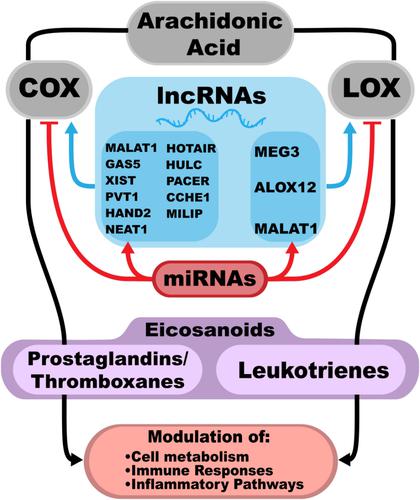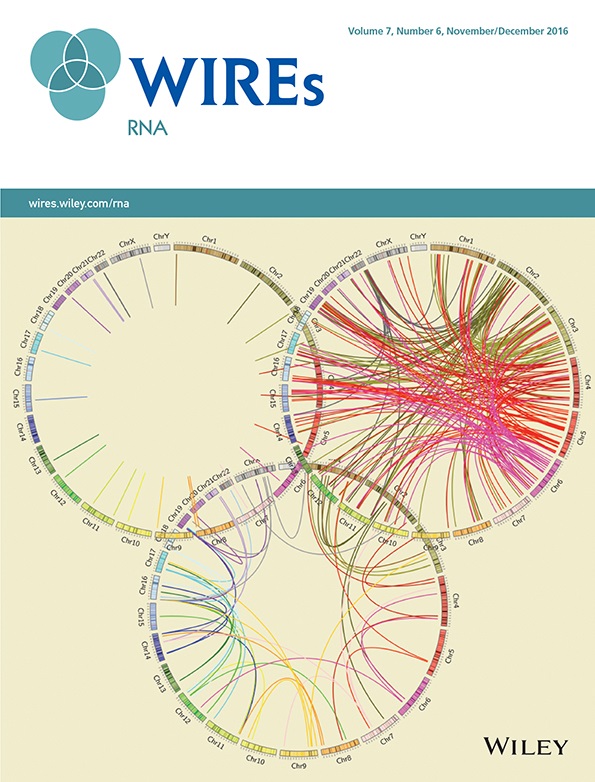长链非编码rna及其在形成和调节花生四烯酸代谢中的复杂作用:学会热爱(并非真正的)垃圾。
IF 4.8
2区 生物学
Q1 CELL BIOLOGY
引用次数: 0
摘要
长链非编码rna (lncRNAs)已成为许多生物过程的关键调控因子。花生四烯酸(AA)代谢途径是一种基本的生化途径,负责将AA(一种20碳ω - 6多不饱和脂肪酸)酶转化为各种有效的脂质信号分子,即类二十烷酸。类二十烷酸是通过AA途径的环加氧酶和脂加氧酶臂产生的,在健康和疾病状态(包括癌症和炎症性疾病)中都具有多种生物学作用。环加氧酶2 (COX-2)是环加氧酶臂的诱导型限速酶,产生两种主要形式的类二十烷:前列腺素和凝血酶。AA通过脂氧合酶臂通过5-脂氧合酶(ALOX5)的作用代谢产生被称为白三烯的二十烷类化合物。COX-2和ALOX5基因的表达通过许多不同的lncrna和microRNA (miRNA)介导的机制进行调控。如前所述,非编码RNA影响COX-2和ALOX5的转录、剪接、选择性聚腺苷化、信使RNA稳定性、翻译和miRNA调控(Lutz和Cornett, 2013, Wiley跨学科评论)。Rna, 4(5), 593-605)。本综述讨论了包括MALAT1、NEAT1、HOTAIR、PACER等在内的lncrna在调节AA通路中的复杂作用。在这篇综述更新中,我们将深入了解AA基因表达调控的进展。我们将探索lncrna及其相关mirna和已知的调节AA信号通路关键组分的蛋白的机制。我们还将讨论靶向lncrna介导的调节的治疗潜力,重点是调节COX-2和ALOX5活性以及下游类二十烷酸的产生,以应用于炎症和肿瘤疾病。本文分类如下:调控RNA /RNAi/核糖开关>调控RNA疾病与发展>疾病中的RNA。本文章由计算机程序翻译,如有差异,请以英文原文为准。

Long noncoding RNAs and their complex role in shaping and regulating arachidonic acid metabolism: Learning to love the (not-really) junk.
Long noncoding RNAs (lncRNAs) have emerged as critical regulators in numerous biological processes. The arachidonic acid (AA) metabolic pathway is a fundamental biochemical pathway responsible for the enzymatic conversion of AA, a 20-carbon omega-six polyunsaturated fatty acid, into a variety of potent lipid signaling molecules known as eicosanoids. Eicosanoids are produced through the cyclooxygenase and lipoxygenase arms of the AA pathway and have diverse biological roles in both healthy and disease states, including cancer and inflammatory diseases. Cyclooxygenase 2 (COX-2), the inducible, rate-limiting enzyme of the cyclooxygenase arm, produces two main forms of eicosanoids: prostaglandins and thromboxanes. AA metabolized through the lipoxygenase arm by the action of 5-lipoxygenase (ALOX5) produces eicosanoids known as leukotrienes. COX-2 and ALOX5 gene expression are regulated through many different lncRNAs and microRNA (miRNA)-mediated mechanisms. As previously reviewed, noncoding RNAs affect transcription, splicing, alternative polyadenylation, messenger RNA stability, translation, and miRNA regulation of COX-2 and ALOX5 (Lutz and Cornett, 2013, Wiley Interdisciplinary Reviews. RNA, 4(5), 593-605). This current review discusses the intricate roles of lncRNAs, including MALAT1, NEAT1, HOTAIR, PACER, and others, in modulating the AA pathway. In this review update, we will delve into advancements in our understanding of AA gene expression regulation. We will explore the mechanisms of lncRNAs and their associated miRNAs and proteins known to regulate key components of the AA signaling pathway. We will also discuss the therapeutic potential of targeting lncRNA-mediated regulation, with a focus on modulating COX-2 and ALOX5 activity and downstream eicosanoid production for applications in inflammatory and oncological conditions. This article is categorized under: Regulatory RNAs/RNAi/Riboswitches > Regulatory RNAs RNA in Disease and Development > RNA in Disease.
求助全文
通过发布文献求助,成功后即可免费获取论文全文。
去求助
来源期刊

Wiley Interdisciplinary Reviews: RNA
CELL BIOLOGY-
CiteScore
14.80
自引率
4.10%
发文量
67
审稿时长
6-12 weeks
期刊介绍:
WIREs RNA aims to provide comprehensive, up-to-date, and coherent coverage of this interesting and growing field, providing a framework for both RNA experts and interdisciplinary researchers to not only gain perspective in areas of RNA biology, but to generate new insights and applications as well. Major topics to be covered are: RNA Structure and Dynamics; RNA Evolution and Genomics; RNA-Based Catalysis; RNA Interactions with Proteins and Other Molecules; Translation; RNA Processing; RNA Export/Localization; RNA Turnover and Surveillance; Regulatory RNAs/RNAi/Riboswitches; RNA in Disease and Development; and RNA Methods.
 求助内容:
求助内容: 应助结果提醒方式:
应助结果提醒方式:


